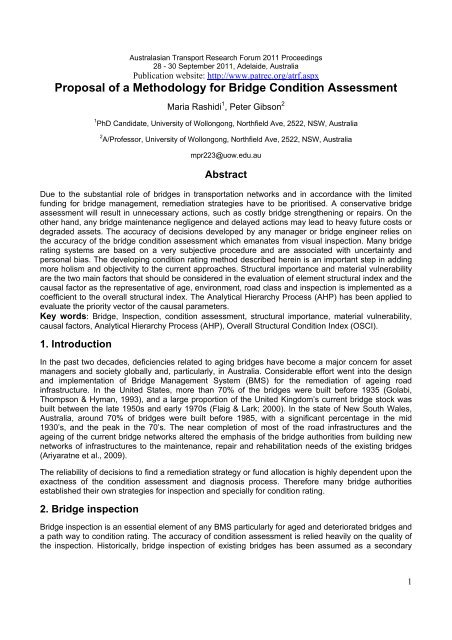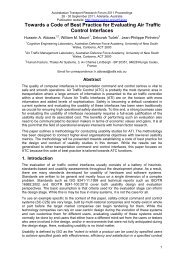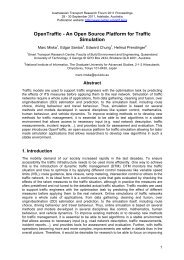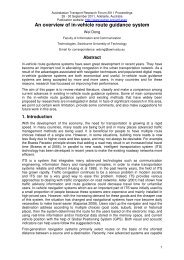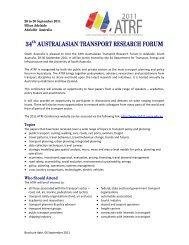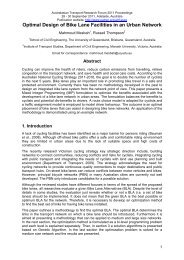Proposal of a Methodology for Bridge Condition Assessment
Proposal of a Methodology for Bridge Condition Assessment
Proposal of a Methodology for Bridge Condition Assessment
You also want an ePaper? Increase the reach of your titles
YUMPU automatically turns print PDFs into web optimized ePapers that Google loves.
Australasian Transport Research Forum 2011 Proceedings28 - 30 September 2011, Adelaide, AustraliaPublication website: http://www.patrec.org/atrf.aspx<strong>Proposal</strong> <strong>of</strong> a <strong>Methodology</strong> <strong>for</strong> <strong>Bridge</strong> <strong>Condition</strong> <strong>Assessment</strong>Maria Rashidi 1 , Peter Gibson 21 PhD Candidate, University <strong>of</strong> Wollongong, Northfield Ave, 2522, NSW, Australia2 A/Pr<strong>of</strong>essor, University <strong>of</strong> Wollongong, Northfield Ave, 2522, NSW, Australiampr223@uow.edu.auAbstractDue to the substantial role <strong>of</strong> bridges in transportation networks and in accordance with the limitedfunding <strong>for</strong> bridge management, remediation strategies have to be prioritised. A conservative bridgeassessment will result in unnecessary actions, such as costly bridge strengthening or repairs. On theother hand, any bridge maintenance negligence and delayed actions may lead to heavy future costs ordegraded assets. The accuracy <strong>of</strong> decisions developed by any manager or bridge engineer relies onthe accuracy <strong>of</strong> the bridge condition assessment which emanates from visual inspection. Many bridgerating systems are based on a very subjective procedure and are associated with uncertainty andpersonal bias. The developing condition rating method described herein is an important step in addingmore holism and objectivity to the current approaches. Structural importance and material vulnerabilityare the two main factors that should be considered in the evaluation <strong>of</strong> element structural index and thecausal factor as the representative <strong>of</strong> age, environment, road class and inspection is implemented as acoefficient to the overall structural index. The Analytical Hierarchy Process (AHP) has been applied toevaluate the priority vector <strong>of</strong> the causal parameters.Key words: <strong>Bridge</strong>, Inspection, condition assessment, structural importance, material vulnerability,causal factors, Analytical Hierarchy Process (AHP), Overall Structural <strong>Condition</strong> Index (OSCI).1. IntroductionIn the past two decades, deficiencies related to aging bridges have become a major concern <strong>for</strong> assetmanagers and society globally and, particularly, in Australia. Considerable ef<strong>for</strong>t went into the designand implementation <strong>of</strong> <strong>Bridge</strong> Management System (BMS) <strong>for</strong> the remediation <strong>of</strong> ageing roadinfrastructure. In the United States, more than 70% <strong>of</strong> the bridges were built be<strong>for</strong>e 1935 (Golabi,Thompson & Hyman, 1993), and a large proportion <strong>of</strong> the United Kingdom’s current bridge stock wasbuilt between the late 1950s and early 1970s (Flaig & Lark; 2000). In the state <strong>of</strong> New South Wales,Australia, around 70% <strong>of</strong> bridges were built be<strong>for</strong>e 1985, with a significant percentage in the mid1930’s, and the peak in the 70’s. The near completion <strong>of</strong> most <strong>of</strong> the road infrastructures and theageing <strong>of</strong> the current bridge networks altered the emphasis <strong>of</strong> the bridge authorities from building newnetworks <strong>of</strong> infrastructures to the maintenance, repair and rehabilitation needs <strong>of</strong> the existing bridges(Ariyaratne et al., 2009).The reliability <strong>of</strong> decisions to find a remediation strategy or fund allocation is highly dependent upon theexactness <strong>of</strong> the condition assessment and diagnosis process. There<strong>for</strong>e many bridge authoritiesestablished their own strategies <strong>for</strong> inspection and specially <strong>for</strong> condition rating.2. <strong>Bridge</strong> inspection<strong>Bridge</strong> inspection is an essential element <strong>of</strong> any BMS particularly <strong>for</strong> aged and deteriorated bridges anda path way to condition rating. The accuracy <strong>of</strong> condition assessment is relied heavily on the quality <strong>of</strong>the inspection. Historically, bridge inspection <strong>of</strong> existing bridges has been assumed as a secondary1
ATRF 2011 Proceedingspriority <strong>of</strong> a semi-random nature. The inspections were usually done as a consequence <strong>of</strong> warningsreceived from sources very <strong>of</strong>ten outside the bridge network system, or as a result <strong>of</strong> an obviousinadequacy <strong>of</strong> the bridge that did not allow it to fulfill the expected function (Branco & de Brito, 2004).The inspection methods in Australia have primarily been extracted from the American Association <strong>of</strong>State Highway and Transportation Officials (AASHTO) and modified by the road authorities. However,many bridge agencies use their own strategies <strong>for</strong> inspection and condition rating but the elementbased inspection is regarded as the most reliable technique <strong>for</strong> condition assessment.To reduce fixed costs and to enhance efficiency, an inspection system must be planned at the bridgenetwork level and not at the single bridge level. The routine inspection schedule should not be changedfrequently and must be per<strong>for</strong>med at fixed period <strong>of</strong> time. The quality <strong>of</strong> the inspection is stronglyrelated to the knowledge and experience <strong>of</strong> the inspectors and compliance with prescribed procedures(Little, 1990).The functionality <strong>of</strong> the management system is based on a standardised inspection plan. It includes aperiodic set <strong>of</strong> inspections based on a fixed timetable in which some flexibility is allowed to take intoaccount a reasonable global allocation <strong>of</strong> inspection resources complemented by special inspectionswhen something serious is detected or suspected (Branco & de Brito, 2004). A variety <strong>of</strong> inspectionsmay be required on a bridge during its service life. The main types <strong>of</strong> inspection are addressed in thefollowing sections.2.1 Initial (inventory) InspectionInitial inspections are per<strong>for</strong>med on new bridges or when existing bridges are first entered into thedatabase. This inspection provides a basis <strong>for</strong> all future inspections or modifications to a bridge.Inventory inspections provide structural inventory and appraisal data along with bridge elementin<strong>for</strong>mation and baseline structural conditions. Inventory inspections usually start in the <strong>of</strong>fice with theconstruction plans and route in<strong>for</strong>mation then proceed to the field <strong>for</strong> verification <strong>of</strong> the as-builtconditions.Initial defects are noted which might not have been present at the time <strong>of</strong> construction. Changes in thecondition <strong>of</strong> the site, such as erosion, scour and re-grading <strong>of</strong> slopes should also be noted (Andrey,1987).2.2 Routine InspectionThe routine inspection is a diagnostic method with the greatest potential and is generally based ondirect visual observation <strong>of</strong> a bridge’s most exposed areas. It relies on subjective evaluations made bythe bridge inspectors. During an inspection, no significant structural defect is expected and the workrecommended falls within the range <strong>of</strong> maintenance.A period <strong>of</strong> fifteen months between routine inspections is recommended so that the influence <strong>of</strong> theweather on the general condition and degradation <strong>of</strong> the bridge can be assessed (Andrey, 1987). Aroutine inspection must be planned in advance to facilitate the best assured conditions (e.g. weatherconditions, traffic) that may permit detection <strong>of</strong> defects (Branco & de Brito, 2004).2.3 Detailed InspectionEasy and fast nondestructive in situ tests are per<strong>for</strong>med in detailed inspection in addition to directvisual observation as a way <strong>of</strong> exploring every detail that may potentially lead to future problems. Thereis a possibility that special means <strong>of</strong> access may be used if such is considered indispensable. The2
Paper title (<strong>Proposal</strong> <strong>of</strong> a <strong>Methodology</strong> <strong>for</strong> <strong>Bridge</strong> <strong>Condition</strong> <strong>Assessment</strong>)period recommended <strong>for</strong> a detailed inspection is five years and replaces a routine inspection if theinspector’s calendars agree (Andrey, 1987). A preliminary visit to the bridge site may be useful toevaluate existing conditions. If there is a need to follow up the evolution <strong>of</strong> certain defects with greaterfrequency, however, the period between visits may be reduced to one year, specially <strong>for</strong> local areas <strong>of</strong>the bridge.According to Branco and de Brito (2004) planning a detailed inspection includes a careful study <strong>of</strong> abridge dossier to get to know the reasons and evolution <strong>of</strong> the defects detected in the previousinspections and the specific points to be assessed closely. Based on previous inspection <strong>for</strong>ms and apreliminary visit to the site, the eventual special means <strong>of</strong> access needed are planned. The followingfiles must be brought to the site and/or prepared be<strong>for</strong>ehand: a list <strong>of</strong> all single points to be checked,schematics with reference grids <strong>of</strong> the most relevant elements, and the last periodic inspection <strong>for</strong>mand the inspection manual.According to the outcomes obtained, the inspection may possibly have one <strong>of</strong> the followingconsequences (Andrey, 1987): the organisation <strong>of</strong> a structural assessment or <strong>of</strong> complementarysurveillance measurements; the preparation <strong>of</strong> a list with particular aspects to follow especially carefullyin the next inspection; the organisation <strong>of</strong> maintenance work needed; and the establishment <strong>of</strong> amedium-term maintenance plan (Branco & de Brito, 2004).2.4 Structural assessmentA structural assessment is normally the consequence <strong>of</strong> the detection <strong>of</strong> a major structural or functionaldeficiency during a routine or detailed inspection. It may also be necessary if widening the deck orstrengthening the structure is under consideration. The expected results from this inspection are: thecharacterisation <strong>of</strong> the structural shortcomings, the remaining service life estimation by usingdegradation mathematical models, and also evaluation <strong>of</strong> its present load-bearing capacity. It is noteasy to predict the required means because a wide range <strong>of</strong> situations can initiate a structuralassessment. The static and dynamic load tests and laboratory tests can be valuable complements tothe in<strong>for</strong>mation collected in situ. Nevertheless, they must be used with some parsimony since, as wellas being expensive, they <strong>for</strong>ce the total interruption <strong>of</strong> traffic over the bridge <strong>for</strong> uncertain periods <strong>of</strong>time (Andrey, 1987). The final report <strong>of</strong> the structural assessment must include the index, structuralidentification <strong>for</strong>m, schematic drawing <strong>of</strong> the bridge, structure general condition standard <strong>for</strong>m,summary <strong>of</strong> the most significant results, equipment used and calibration sheets, photos and schematicrepresentations <strong>of</strong> the cores, identification and description <strong>of</strong> the cores, identification and description <strong>of</strong>the asphalt surface samples, photos and drawings. All the data collected are dated and appended tothe bridge dossier (OMT, 1988).2.5 Special InspectionThis could be undertaken to cover special conditions such as occurrences <strong>of</strong> earthquakes, unusualfloods, passage <strong>of</strong> high intensity loading, etc. These inspections should be supplemented by testing aswell as structural analysis. For that reason the inspection team should include an experienced bridgedesign engineer (Raina, 2005).2.6 Underwater InspectionAn underwater inspection is per<strong>for</strong>med on bridges with structural elements partially located under waterthat are not easily accessible <strong>for</strong> inspection, and generally the inspection interval should not exceedsixty months (Washington State <strong>Bridge</strong> Inspection Manual, 2006). Underwater inspections areundertaken by experienced divers to assess the material condition specific material type and takeunder water photographs/videos as necessary.3
ATRF 2011 Proceedings3. Development <strong>of</strong> a unified bridge condition rating<strong>Bridge</strong> condition assessment is the evaluation <strong>of</strong> differences between the as-designed, as-built, and asisstates <strong>of</strong> the structures. The subject can be a bridge component, a group <strong>of</strong> similar elements within aspan, or in all spans, components, and eventually the entire bridge. The outcome determines thesufficiency <strong>of</strong> monitoring and maintenance and the effects <strong>of</strong> traffic and the environment and definingthe present and future needs (Yanev, 2007).<strong>Bridge</strong>s are complex mixture <strong>of</strong> parallel and series systems, but almost all BMS use the evaluation <strong>of</strong>members or elements as input to calculate the overall structural reliability (Yanev, 2007). The review <strong>of</strong>the current practices in bridge condition evaluation reveals the need <strong>for</strong> a unified condition ratingprocedure in order to use the accessible data collected during the inspection and to account <strong>for</strong>uncertainty and complexity issues associated with the detailed visual inspection process (Abu Dabousand Alkass, 2010).With the purpose <strong>of</strong> being consistent with the majority <strong>of</strong> bridge inspection practices the recommendedmethodology is an element level index based on four condition states defined in the Road and TrafficAuthority (RTA) in New South Wales in which the bridge element condition ranges from 1 to 4 in risingorder. The general description <strong>of</strong> the four condition states <strong>for</strong> rein<strong>for</strong>ced concrete bridge elements ispresented in Table 1. In this system the bridge is divided into elements generally made <strong>of</strong> a similarmaterial (Most bridges have about ten to twelve elements and bridge sized culverts usually have threeto five elements). The inspector estimates and records the quantities <strong>of</strong> the bridge element in eachcondition state independently. The total quantity must be measured in the correct units <strong>for</strong> theelements. The units <strong>of</strong> measurement are square meters (deck, pier, and pile), meters (joints andrailings) or each (bearing pad, waterway, etc).Table 1: <strong>Condition</strong> states <strong>for</strong> concrete bridge elements (RTA, 2007)<strong>Condition</strong>State1Description <strong>of</strong> defectsThe element shows no deterioration. There may be discolouration,efflorescence and/or superficial cracking but without effect on strength and/ orserviceability.2Minor cracks and spalls may be present but there is no evidence <strong>of</strong> corrosion <strong>of</strong>non-prestressed rein<strong>for</strong>cement or deterioration <strong>of</strong> the prestress system.3Some delaminations and/or spalls may be present. No evidence <strong>of</strong>deterioration <strong>of</strong> the prestress system. Corrosion <strong>of</strong> non-prestressedrein<strong>for</strong>cement may be present bot loss <strong>of</strong> section is minor and does notsignificantly affect the strength and/or serviceability <strong>of</strong> either the element or thebridge.4Delaminations, spalls and corrosion <strong>of</strong> non-prestressed rein<strong>for</strong>cement areprevalent. There may also be exposure and deterioration <strong>of</strong> the prestresssystem (manifested by loss <strong>of</strong> bond, broken strands or wire, failed anchorages,etc). There is sufficient concern to warrant an analysis to ascertain the impacton the strength and/or serviceability <strong>of</strong> either the element or the bridge.4
Paper title (<strong>Proposal</strong> <strong>of</strong> a <strong>Methodology</strong> <strong>for</strong> <strong>Bridge</strong> <strong>Condition</strong> <strong>Assessment</strong>)The following example shows the bridge element condition concept. The data used in this example hasbeen extracted from a bridge inspection report provided by Road and Traffic Authority <strong>for</strong> a concretebridge in Illawarra region. The condition inspection results <strong>of</strong> pile element with a total area <strong>of</strong> 695 m 2are presented in Table 2.Table 2: <strong>Bridge</strong> Pile <strong>Condition</strong> Rating Results<strong>Condition</strong> Rate Area (m 2 )1 6182 33 744 0The overall condition <strong>of</strong> piles = [(618×1) + (3×2) + (74×3) + (0×4)] / [695×1] =3.01As can be seen above the element condition index can be calculated as the current value divided bythe initial value <strong>of</strong> the bridge element. To describe the overall condition status <strong>of</strong> structural elements,the Element Structural <strong>Condition</strong> Index (ESCI) is introduced as: ∑ ∑ -q i is the quantity <strong>of</strong> elements reported in condition index C i-C i is the condition <strong>of</strong> sub-element c i (1,2,3,4)As can be seen in the ESCI estimation process, deterministic values are used as an approximation <strong>for</strong>the element value at each <strong>of</strong> the four condition states. Quantities can also be used <strong>for</strong> the costestimation <strong>of</strong> probable maintenance work. This approximation may not be quite reliable, since datacollected through inspection process is usually associated with subjectivity and uncertainty (Aboudabusand Alkass, 2010). Many attempts have been conducted to reduce the uncertainty. For exampleColorado Department <strong>of</strong> Transportation suggested a frame work <strong>for</strong> condition rating <strong>of</strong> deck crackingwhich is shown in Table 3.Table 3: <strong>Condition</strong>s Rating <strong>of</strong> Deck Cracking (Colorado Department <strong>of</strong> Transportation, 1995; Abu Dabouset al., 2008)Crack Width (mm)Spacing <strong>of</strong> Cracks in Concrete Deck (m)>3 2-3 1-2
ATRF 2011 Proceedingsstructural/ material vulnerability <strong>of</strong> various bridge elements is a difficult task. Sometimes doing somestructural analysis such as non-destructive testing program is unavoidable. Alternatively, bridge expertsand inspectors can rely on their own experience and knowledge to determine these factors.3.1 Material Vulnerability FactorAccording to Valenzuela et., al (2010) and Austroads (2004) material factor is an important parameterthat should be considered in structural assessment <strong>of</strong> bridge elements. Based on vulnerability <strong>of</strong>different material it ranges between 1 (steel) and 4 (precast concrete) (See Table 4). The greater Mireflects the higher material vulnerability.Table 4: Material Vulnerability Factor MiMaterial <strong>of</strong> the elementSteel 1Rein<strong>for</strong>ced Concrete 2Precast concrete 3Pre stressed concrete 4Material Vulnerability Factor, mi3.2 Structural Significance FactorGenerally, the prevailing condition (rating) <strong>of</strong> the particular element may cause some inaccuracies inthe overall structural assessment. For example, a minor component with worse condition mayunreasonably raise the rating value <strong>of</strong> that element under which the component is grouped. Thisproblem can be dealt with the introduction <strong>of</strong> element structural significance factor which is notdependent on the prevailing condition <strong>of</strong> components (Samsal and Ramanjaneyulu, 2008).The evaluation incorporates many parameters and human judgments that may cause the procedure tobe slightly uncertain and imprecise. Tee et al., (1988), Melhem and Aturaliya (1996), Samsal andRamanjaneyulu (2008) and Abu Dabous and Alkass (2010) tried to employ a systematic approach toquantify the structural importance <strong>of</strong> various bridge elements. Tee et al., (1988) defined the structuralsignificance as the role <strong>of</strong> an element in comparison to the other components and quantified this factor<strong>for</strong> different elements at different condition rating based on survey results responded by 46 inspectorsand bridge experts. Abu Dabous and Alkass (2010) described the structural importance <strong>of</strong> a bridgecomponent as the level the component contributes to the overall structural safety and integrity <strong>of</strong> thebridge and proposed the Analytical Hierarchy Process (AHP) to estimate the value <strong>of</strong> that parameter. Inthis research the Element Structural Significance has been investigated through conducting semistructuredfield interviews with bridge engineers/ inspectors. The outcome <strong>of</strong> the processed expertjudgments considering the results <strong>of</strong> previous research is summarised in Table 5. The higher numbersrepresent the superior importance.Table 5: Structural Significance Factor SiElementBarrier, Footway, Kerbs, Joints 1Foundation, Abutment, Wingwall 2Deck, Bearings 3Beams, Headstocks, Piers 4Structural Significance Factor, S i6
Paper title (<strong>Proposal</strong> <strong>of</strong> a <strong>Methodology</strong> <strong>for</strong> <strong>Bridge</strong> <strong>Condition</strong> <strong>Assessment</strong>)3.3 Causal Factor<strong>Bridge</strong> elements deteriorate over an extended period <strong>of</strong> time and the rate <strong>of</strong> deterioration is a function<strong>of</strong> various parameters. The environment the structure is located in, the length <strong>of</strong> time the structure hasbeen in service (Age), the function the structure is required to per<strong>for</strong>m (Road Class) and the quality <strong>of</strong>inspection and monitoring (Figure 1).Figure 1: The causal factors3.3.1 Environmental Factor:This parameter considers natural/ man caused environmental actions that cause chemical and physicaldeterioration <strong>of</strong> concrete. The major concerns are freeze and thaw cycles; chloride ingress, sulphateattack, acid attack and alkali-aggregate reaction (Rashidi and Lemass 2011).3.3.2 Age Factor:As bridges are designed to withstand fatigue loading (which increases with time), age is an importantparameter involved in structural condition assessment. The life expectancy <strong>of</strong> current bridges is about50 years and <strong>for</strong> major concrete bridges is around 100 years. In fact, <strong>for</strong> the structural safety <strong>of</strong> thebridge, the designers have the reference code actions, usually defined <strong>for</strong> a period <strong>of</strong> 50 years. Theyneed to adopt durability measures <strong>for</strong> 100 years, but the code indications are usually referred to 50years. They need to consider <strong>for</strong> that bridge bearings and other equipment capable <strong>of</strong> lasting at most25 years. When service life is raised beyond the current 50 years, the study <strong>of</strong> major bridges requiresthat safety be reconsidered to integrate coherence into the design (Branco & de Brito, 2004). Theservice life <strong>of</strong> a bridge brings to end when one <strong>of</strong> the key components fails to function as designed. Therating <strong>of</strong> this factor is presented in Table 6. “Recently built” is allocated <strong>for</strong> the first quarter <strong>of</strong> bridgeservice life, “New”, “Old” and “Very Old” are respectively assigned <strong>for</strong> the second, third and last quarter<strong>of</strong> that.7
ATRF 2011 Proceedings3.3.3 Inspection Factor:Quality and frequency <strong>of</strong> inspection play a key role in structural reliability <strong>of</strong> bridges. The inspectiondata provides an inclusive in<strong>for</strong>mation source to track the condition development trends <strong>of</strong> bridgestructures. However uncertainties and fuzziness associated to the inspection data cause manyproblems in its application (Wang and Foliente, 2008). Some <strong>of</strong> the probable errors in inspectionprocess are as follows (Yanev, 2007):-Inadequacy <strong>of</strong> equipments-Exaggeration <strong>of</strong> some defects (loss <strong>of</strong> steel cross section to corrosion is usually overstated)-The inability to recognise structurally significant features, such as support condition, bridge skew,fracture-critical members, and fatigue-sensitive details.-Fear <strong>of</strong> traffic-Lack <strong>of</strong> proper inspection training-Inappropriate <strong>for</strong>ms/ check lists-Accessibility-Visibility-Time constraints-Wind, rain and snow3.3.4 Road Type Factor:This factor is involved based on usage and importance <strong>of</strong> the bridge to the network addressing the roadtype <strong>of</strong> the bridge including street, road, freeway (FWY) or highway (HWY), bridge environment such asrural or urban, and the feature crossed such as road, waterway and railway (Wang and Foliente, 2008).3.3.5 Rating and priority vector <strong>of</strong> the causal factors:All the above mentioned factors have been classified based on definitions pointed out in section 3.3.1,3.3.2, 3.3.3 and 3.3.4 and rated from 1 to 4 as such the higher numbers are associated with higherseverity (Table 6).Table 6: Rating <strong>of</strong> the causal factorsRatingCausal FactorsAge Road Class EnvironmentInspectionQuality1 Recently built Minor Low Very High2 New Local access Medium High3 Old Collectors High Medium4 Very old Arterials Very High Low8
Paper title (<strong>Proposal</strong> <strong>of</strong> a <strong>Methodology</strong> <strong>for</strong> <strong>Bridge</strong> <strong>Condition</strong> <strong>Assessment</strong>)For the purpose <strong>of</strong> finding the priority vector <strong>of</strong> the contributed factors, Analytical Hierarchy Process(AHP) developed by Saaty (1980) has been chosen. Fourteen experts (mainly bridge engineers andasset managers) have been asked to compare the involved parameters in pair and specify the quantity<strong>of</strong> the relative importance according to the Table 7.Table 7: 1-9 scales <strong>for</strong> relative importance (Saaty 1980)Importance IntensityExplanation1 Equal importance3 Moderate importance <strong>of</strong> one over another5 Strong importance <strong>of</strong> one over another7 Very strong importance <strong>of</strong> one over another9 Absolute importance <strong>of</strong> one over another2,4,6,8 Intermediate values between the twojudgmentsReciprocalsReciprocal <strong>for</strong> inverse comparisonThe results <strong>of</strong> pairwise comparison are entered in a reciprocal comparison matrix as shown in Table 8.The importance level <strong>of</strong> the causal factors is developed as a vector <strong>of</strong> priorities which is a normalisedeigenvector and estimated by dividing each element by the sum <strong>of</strong> that column and then computing theaverage <strong>of</strong> each row that shows the priority weight <strong>of</strong> the corresponding element.Table 8: Pairwise comparison <strong>of</strong> the causal factors and their final weightsAge Environment Road Class Inspection WeightsAge 1 3 5 1 0.411Environment 1/3 1 1 1/3 0.120Road Class 1/5 1 1 1/3 0.107Inspection 1 3 3 1 0.362The Causal Factor (CF) is calculated as follows. It ranges from 1-4: 0.411 0.120 0.107 0.362-A is the age factor-E is the environmental factor-R is the road type factor-I is the inspection factor9
ATRF 2011 Proceedings3.3.6. Overall Structural <strong>Condition</strong> IndexThe Structural Health Index (SHI) integrates all <strong>of</strong> the abovementioned parameters that influencestructural efficiency and estimated as follows: ∑ -CF is the causal factor-Si is the structural importance factor-Mi is the material vulnerability factor-ESCIi is the Element Structural <strong>Condition</strong> Index-n is the number <strong>of</strong> element typesThe range <strong>of</strong> SHI is 1-256. This index will be applied <strong>for</strong> prioritisation <strong>of</strong> bridges in a network. Thepriority <strong>for</strong> remedial actions increases as the number rises.Considering the identical upper limit (4) and lower limit (1) <strong>of</strong> all parameters and in order to keep theuni<strong>for</strong>mity <strong>of</strong> quantity ranges, the condition <strong>of</strong> an entire structural element introduced as OverallStructural <strong>Condition</strong> Index (OSCI) has been re-rated based on HIS and defined as:OSCI=1,OSCI=2,OSCI=3,OSCI=4,when SHI=1when 1
Paper title (<strong>Proposal</strong> <strong>of</strong> a <strong>Methodology</strong> <strong>for</strong> <strong>Bridge</strong> <strong>Condition</strong> <strong>Assessment</strong>)These levels implied that corrosion was past the acceptable threshold, and remediation was requiredthat could slow the degradation process. The Structural Health Index (SHI) <strong>for</strong> bridge X was 33.64. Incomparison to the condition index <strong>of</strong> the other bridges in the network (Y=7.872, Z=9.216, T=15.04 andU:20.736) it had the highest rate and there<strong>for</strong>e has been targeted as a top priority <strong>for</strong> remedial action.Table 9: Evaluation <strong>of</strong> the Overall Structural <strong>Condition</strong> Index (OSCI) <strong>for</strong> bridge XSummary and ConclusionA methodology <strong>for</strong> developing an element based structural index is presented. OSCI is expressed as anumber 1 to 4 and enables the decision makers to simply understand and compare the condition <strong>of</strong> avariety <strong>of</strong> bridges in the network. OSCI <strong>of</strong> 4 corresponds to the worst condition <strong>of</strong> a bridge and OSCI <strong>of</strong>1 represents a new bridge. Material vulnerability (Mi) and Structural importance (Si) are considered inthe element based condition assessment and the critical parameters that influence structural efficiencyare identified as age, environment, road type and inspection. The weight <strong>of</strong> each <strong>of</strong> those factors hasbeen evaluated through AHP, and the overall influence factor, which is introduced as Causal Factor(CF) is implemented as a coefficient to the current structural condition. This methodology has been11
ATRF 2011 Proceedingsexamined in a network consisting <strong>of</strong> 5 bridges in order to prioritise them <strong>for</strong> maintenance actions andbudget allocation.ReferencesAustroads (2004), “Guidelines <strong>for</strong> <strong>Bridge</strong> Management: Structure In<strong>for</strong>mation”, Published by AustroadsIncorporated.Abu Dabous S and Alkass S (2008). "A probabilistic methodology <strong>for</strong> bridge deck conditionassessment." <strong>Bridge</strong> Structures 4(1): 49-56.Abu Dabous S and Alkass S (2010) “A Stochastic Method <strong>for</strong> <strong>Condition</strong> Rating <strong>of</strong> Concrete <strong>Bridge</strong>s”.ASCE Conf. Proc.Abu Dabous S and Alkass S (2010) “A multi-attribute ranking method <strong>for</strong> bridge management”, Journal<strong>of</strong> Engineering, Construction and Architectural Management Volume 17( 3), pp 282-291, 2010.Andrey, D. (1987) <strong>Bridge</strong> Maintenance: Surveillance <strong>Methodology</strong> (in French), PhD Thesis, Lausanne,Switzerland.Ariyaratne et., al (2009) “Development <strong>of</strong> a model <strong>for</strong> assessment <strong>of</strong> future condition <strong>of</strong> bridges”University <strong>of</strong> Technology Sydney, Centre <strong>for</strong> built infrastructure research.Branco F.A, and Brito. J.(2004) ,“Handbook <strong>of</strong> Concrete <strong>Bridge</strong> Management”, ASCE Press.Colorado Department <strong>of</strong> Transportation (1995). “BMS/Points <strong>Bridge</strong> Inspection Manual”, ColoradoDept. <strong>of</strong> Transportation, Denver, USA.Flaig, K.D. and Lark, R.J. (2000), ‘The development <strong>of</strong> UK bridge management systems”, Proc.InstnCiv. Engrs Transp., Vol. 141, May, pp. 99-106.Golabi K, Thompson P, Hyman W.(1993), ‘Points: a network optimization system <strong>for</strong> bridgeimprovements and maintenance Technical manual’, Publication number FHWA-SA_94-031: USDepartment <strong>of</strong> Transportation, Federal Highway Administration.Little, R. (1990). “A data based management system <strong>for</strong> the inspection <strong>of</strong> a large number <strong>of</strong> bridges,”Developments in Short and Medium Span <strong>Bridge</strong> Engineering ’90, Toronto, Ontario, Canada.Melhem H. G and Aturaliya S.(1996). "<strong>Bridge</strong> <strong>Condition</strong> Rating Using an Eigenvector <strong>of</strong> PrioritySettings." Computer-Aided Civil and Infrastructure Engineering 11(6): 421-432.OMT. (1988) “Structure Rehabilitation Manual,” Structural Office, <strong>Bridge</strong> management Section, OntarioMinistry <strong>of</strong> Transportation, Ontario, Canada.Raina V.K. (2005) Concrete <strong>Bridge</strong>s: Inspection, Repair, Strengthening, Testing and Load CapacityEvaluationRashidi M and Lemass B (2011), “Holistic decision support <strong>for</strong> bridge remediation”. The 4 th InternationalConference on Construction Engineering and Project Management”ICCEPM, S2-4.Rashidi M, Lemass B, and Gibson. P (2010), “A decision support system <strong>for</strong> concrete bridgemaintenance”., Proceedings <strong>of</strong> ISCM II & EPMESC XII (pp. 1372-1377).12
Paper title (<strong>Proposal</strong> <strong>of</strong> a <strong>Methodology</strong> <strong>for</strong> <strong>Bridge</strong> <strong>Condition</strong> <strong>Assessment</strong>)Road & Traffic Authority <strong>of</strong> New South Wales (2007), RTA <strong>Bridge</strong> Inspection Procedure, RTA, Sydney,NSW.Saaty, T. L (1980) “The Analytic Hierarchy Process”. New York: McGraw-Hill.Sasmal, S. and K. Ramanjaneyulu (2008). "<strong>Condition</strong> evaluation <strong>of</strong> existing rein<strong>for</strong>ced concrete bridgesusing fuzzy based analytic hierarchy approach." Expert Systems with Applications 35(3): 1430-1443.Tee. A.B , Browman M. D. and Sinha K.C (1988). “A fuzzy mathematical approach <strong>for</strong> bridge conditionevaluation” Journal: Civil engineering systems, Vol.2.Valenzuela et.,al (2010) “<strong>Proposal</strong> <strong>of</strong> an integrated index <strong>for</strong> prioritisation <strong>of</strong> bridge maintenance”Journal <strong>of</strong> <strong>Bridge</strong> Engineering, Volume 15, Issue 3.Wang, X. and. Foliente G (2008). "Identifying bridge structural condition development trendsvia categorical inspection condition rating with case studies." Structure and InfrastructureEngineering 4(6): 449-466.Washington State <strong>Bridge</strong> Inspection Manual (2006) Page 1-9.Yanev, B. (2007) “<strong>Bridge</strong> management” published by John Wiley & Sons, Inc., Hoboken, New Jersey.13


